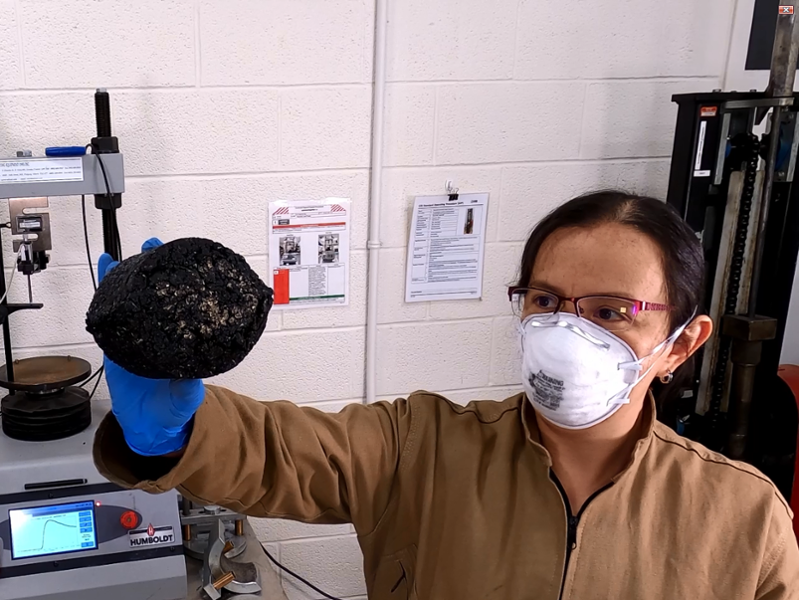Why does spring bring potholes? An engineering researcher fills us in.
Author: UNB Research
Posted on May 6, 2021
Category: Research

Potholes. They’re the one spring bloom we all love to hate. But how do they happen, and why are they so hard to prevent? Dr. Xiomara Sanchez, P.Eng, assistant professor in the department of civil engineering at UNB, clears the snow from this topic:
What are potholes?
Potholes are bowl-shaped depressions in the pavement surface.
Roads are made of pavement, of course, but this paved surface is more than the asphalt you see on top. A conventional pavement is composed of four layers of material.
At the bottom, the natural soil provides an initial foundation. Next come one or two layers of crushed gravel.
On top of the gravel, there are two layers of asphalt concrete. The first layer is for support and the second layer is a smooth yet skid-resistant surface. Both layers contain a mix of high-quality crushed gravel, sand and asphalt binder. Concrete isn’t just the grey material we use for buildings, which is technically known as Portland Cement Concrete. The term concrete is used for a manufactured composite material made with a mixture of broken rocks held together by a binding agent.
The thickness and the properties of the materials used for each of these layers depend on the requirements of the roadway. For example, high traffic areas, or areas with weak natural soils, may require thicker layers, which require more materials production, transportation and placement thus increasing the total construction cost.
Why do they show up in spring?
Spring is the time of year that potholes seem to appear on roads overnight.
With the more rapid temperature fluctuations that come with the beginning of the spring, when the days get warmer, but the nights stay cooler, the frequency of freezing and thawing cycles increases. The snow and ice that covers the surface begins to melt, becoming water which soaks into the different layers of soil and gravel. The strength of the soil varies with the moisture content, and when the moisture content in above its optimum level, soil becomes weak and unstable. Consequently, road agencies sometimes place temporary vehicle weight restrictions to protect the pavement from further damage.
The top-most asphalt layers are also susceptible to water damage, because prolonged exposure to water breaks the bonds both within the asphalt and between the asphalt layers.
This happens when the water trapped in the asphalt turns into ice. As water freezes into ice, in increases in volume, creating an internal force that pushes against the material, causing cracks in the road surface. These cracks exacerbate the problems by creating more space for water to become trapped, in turn creating a vicious circle in which the cracks grow bigger. The cracks can interconnect with others, resulting in chunks of the road beginning to heave up and be pushed about by ice, water and traffic.
How can civil engineers help manage this problem?
This kind of question is one that Dr. Sanchez works to answer.
She has two main areas of research, pavement materials and pavement asset management, and her research efforts are oriented towards promoting more sustainable paving practices. Dr. Sanchez led the modernization of the asphalt laboratory, which, thanks to the department of civil engineering and support from the Engineering Program Fund (EPF), was opened in March 2018.
The laboratory currently enables the design and production of asphalt mixtures, as well as testing for quality control and performance of the material. Dr. Sanchez’s research activity has been primarily dedicated to studying the potential for recycling and using alternative sources for pavement materials, and she has investigated the use of reclaimed asphalt pavement, tear-off shingles and post-consumer plastic as potential materials. Currently, she is also investigating the use of biochar, a special kind of charcoal-like material produced from agricultural and forestry biomass that is cleaner than charcoal, and bio-oil modified asphalt, which are more sustainable asphalts that use biomass-derived oils instead of crude oil as a binder.
What can you do?
There are several ways to control the extent of this seasonal damage.
First, the most important technique is to provide adequate drainage on roadways – you may have noticed that roads curve down at the edges for this very reason. Prompt clearing of snow and ice off the road surface, gutters and drains allows water to be removed quickly and completely. Sometimes, this isn’t possible for many reasons, including costs and access.
Second, selecting materials properly when building or fixing a road can create more resistant roads. But because roads are all season, we need to find an asphalt that can withstand both the hot temperatures in the summer and the cold temperatures in the winter.
Third, ensuring that roads are well-designed and constructed will maximize their lifespans.
Fourth, applying proper asset management practices, so that roads are repaired and maintained in a timely manner, means that damage can be minimized.
Fifth, by exploring innovative technologies and creating new, reasonably priced materials, we can advance the baseline integrity of the road forward.
While it is frustrating for road users to drive on pothole-covered roads, road agencies do what they can by providing temporary repairs in critical areas, despite the difficult working conditions during the winter and spring. Careful driving can help avoid damage to both your vehicle and the roadway – for instance, by slowing down when safe to do so when you see puddles of water in the road, which could be a sign of a deep pothole.